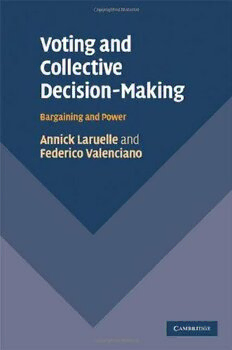
Voting and Collective Decision-Making: Bargaining and Power PDF
203 Pages·2008·0.944 MB·English
Most books are stored in the elastic cloud where traffic is expensive. For this reason, we have a limit on daily download.
Preview Voting and Collective Decision-Making: Bargaining and Power
Description:
Every day thousands of decisions are made by all kinds of committees, parliaments, councils and boards by a 'yes-no' voting process. Sometimes a committee can only accept or reject the proposals submitted to it for a decision. On other occasions, committee members have the possibility of modifying the proposal and bargaining an agreement prior to the vote. In either case, what rule should be used if each member acts on behalf of a different-sized group? It seems intuitively clear that if the groups are of different sizes then a symmetric rule (e.g. the simple majority or unanimity) is not suitable. The question then arises of what voting rule should be used. Voting and Collective Decision-Making addresses this and other issues through a study of the theory of bargaining and voting power, showing how it applies to real decision-making contexts.
See more
The list of books you might like
Most books are stored in the elastic cloud where traffic is expensive. For this reason, we have a limit on daily download.
